Company ties, history of fires and failures, raises troubling questions
By Miriam Raftery
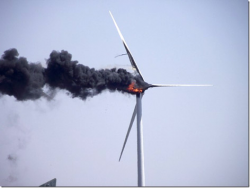
August 6, 2012 (San Diego’s East County) – After researching problems with Gamesa wind turbines and blades, ECM asked Iberdrola PR representative Michelle Sinning whether Iberdrola plans to use Gamesa products at the Tule Wind site in McCain Valley.
“I haven’t heard anything about Gamesa,” Sinning said. She indicated she would obtain a statement and get back to us by tonight's deadline (she didn't), but added that Iberdrola will not make a decision on which suppliers to use until after contracts are signed in order to have flexibility to take advantage of the best “pricing and innovations” on the market.
Perhaps Ms. Sinning should do her homework.
In a December 2011 article titled “Iberdrola and Games bolster wind power ties” , Business Green reported that Iberdrola has announced that it will purchase at least half of the wind turbines it requires between 2013 and 2022 from Gamesa. Iberdrola further controls 19.6% of Gamesa’s shares and has forced management change at the company according to a Financial Times story.
Why should we care?
Because Gamesa has a troubled track record of turbines that have caught fire, as well as washing its hands of responsibility for blade failures including those at the Kumeyaay Wind Farm in Campo, right here in East County.
On May 22, 2012, a Gamesa turbine caught fire at Iberdrola’s Barton 2 Wind Power Project in Iowa, North American Windpower reported. A Gamesa spokesman claimed the company’s maintenance contract had expired.
Gamesa turbines have also been linked to two turbine fires in Pennsylvania, including Iberdrola’s Locust Ridge project in 2009 and another fire at North Allegheny Ridge (not owned by Iberdrola) in 2012. Iberdrola previously had issues with Gamesa turbine blades whirling off chunks of turbine debris at the same facility. ECM has previously reported on these issues and other turbine safety concerns in an April 4, 2012 report, “The Dark Side of Green.”
Both Gamesa and Vestas have warned of problems in older models installed in the late 1990s and early 2000s. However fires at plants with more recent installations make clear that fire and safety issues have still not been adequately addressed.
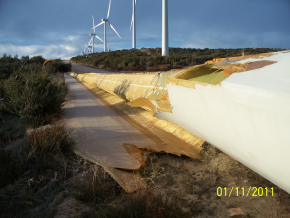 Gamesa has refused to accept liability in five legal actions filed by U.S. wind projects over warranty disputes for hefty repairs and lost production. That includes $34.5 million in turbine repairs at the Kumeyaay Wind Farm in on the Campo Indian reservation. A witness told ECM that he saw a blue flash that radiated out through the wind farm during a storm in December 2009 before the project went dark. All 75 blades on all 25 turbines were replaced and the facility was offline for three months. (View court documents)
Gamesa has refused to accept liability in five legal actions filed by U.S. wind projects over warranty disputes for hefty repairs and lost production. That includes $34.5 million in turbine repairs at the Kumeyaay Wind Farm in on the Campo Indian reservation. A witness told ECM that he saw a blue flash that radiated out through the wind farm during a storm in December 2009 before the project went dark. All 75 blades on all 25 turbines were replaced and the facility was offline for three months. (View court documents)
Gamesa blades suffered from “design and manufacturing defects,” the suits allege, Recharge News has reported. In December 2011, Recharge reported that Infigen, which recently took over the Campo project, had sent a bill to Kumeyaay after the company was unable to get Gamesa to pay up. Kumeyaay has been disputing the claim, contending that Gamesa operated the project for five years. The Campo wind farm was built by Pattern Energy, which listed the Campo project among its “successes” in its application to the California Public Utilities Commission to build Ocotillo Express wind in Ocotillo, California.
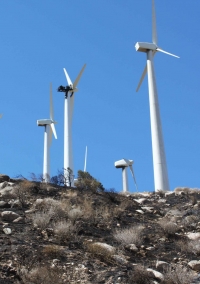 Gamesa isn’t the only turbine maker with a troubled record. As previously noted, Vestas has been plagued with problems. Last week in Tehachapi, a turbine built by Danish manufacturer NEG Micon burst into flames. In June, a wind turbine fire in the Whitewater area of Riverside County charred 367 acres after spreading to become a wild land fire despite the required clearance around turbine bases; fire authorities have not released the name of the turbine maker. The fire, which forced evacuations of homes, could have been far worse had not a witness reported it promptly to 911.
Gamesa isn’t the only turbine maker with a troubled record. As previously noted, Vestas has been plagued with problems. Last week in Tehachapi, a turbine built by Danish manufacturer NEG Micon burst into flames. In June, a wind turbine fire in the Whitewater area of Riverside County charred 367 acres after spreading to become a wild land fire despite the required clearance around turbine bases; fire authorities have not released the name of the turbine maker. The fire, which forced evacuations of homes, could have been far worse had not a witness reported it promptly to 911.
Nor are fires and serious safety issues limited to turbines. In Hawaii, on August 2, 2012 a fire destroyed a battery warehouse at First Wind’s Kahuka wind farm. A previous fire had also occurred in the battery facility in April 2011, the Honolulu Star Advertiser reports. The battery energy storage system designed by Xtreme Power of Texas had been touted as a solution to power spikes.
In 2009, a GE wind turbine broke in half at a New York wind facility owned by Enel, a company seeking to build a wind project in East County’s Jewel Valley. GE, which has also had problems with ice throws off turbines, now recommends that turbines be sited a safe distance from occupied structures, roads or areas used by the public. In May 2012, GE expanded its wind operations by acquiring the wind division of ENRON , the energy company that had its chief executives convicted of fraud following energy market manipulations. Is this a company whose products should be entrusted to protect public safety?
In McCain Valley, site of the proposed Tule Wind facility, turbines up to 450 feet tall with wing 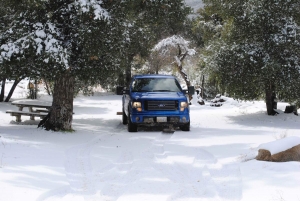 spans the size of football fields would be located just 455 feet from the main roadway and just 760 feet from a campground, Iberdrola told ECM. Moreover there is only one road in and one road out of the long valley. What happens if a turbine collapses or worse, a turbine sparks a fire while campers are present? Or ice is hurled off blades?
spans the size of football fields would be located just 455 feet from the main roadway and just 760 feet from a campground, Iberdrola told ECM. Moreover there is only one road in and one road out of the long valley. What happens if a turbine collapses or worse, a turbine sparks a fire while campers are present? Or ice is hurled off blades?
One unlucky man, Mark Ketterling, was cut in half by ice falling off a wind turbine. McCain Valley is subject to heavy snowfalls.
Texas state representative described a turbine fire on her ranch as hurling “balls of fire” to the ground.
Another issue is that some rural fire departments lack equipment and ladders tall enough to reach a 450-foot-tall turbine, forcing firefighters on the ground to watch helplessly from below. Aerial firefighting can be impeded by power lines which are present at wind farms, until power is de-energized by SDG&E, in the case of Tule Wind. Thus having water storage on site, as Iberdrola has offered to provide, may not be adequate to prevent a turbine fire from escalating into a wildfire fire in an area noted for strong Santa Ana winds and dry brush.
 Mark Ostrander, a retired Cal Fire battalion chief, testified to San Diego’s Planning Commission that wind turbines in McCain Valley, along with Sunrise Powerlink, “will hamper aerial firefighting.” He warned, “If we have a fire start in a wind area, we’re going to have to wait until it comes out, for the safety of the firefighters.”
Mark Ostrander, a retired Cal Fire battalion chief, testified to San Diego’s Planning Commission that wind turbines in McCain Valley, along with Sunrise Powerlink, “will hamper aerial firefighting.” He warned, “If we have a fire start in a wind area, we’re going to have to wait until it comes out, for the safety of the firefighters.”
But who is going to protect the safety of campers, hikers, or residents near the recreational area if a wildfire starts at Tule Wind? (Even in a best case scenario with turbines that function properly, there is still increased risk of fire due to towering turbines attracting lightning strikes, as has also happened at wind facilities around the world. View a photo, posted on the Weather Channel.)
Is putting hundreds of lightning rods up across East County really a good idea?
Iberdrola commissioned a study by Richard P. Thompson, PhD, at California Polytechnic State University, on wildfire risks. "The final probability of a fire occurring and escaping containment of 0.0033% should remain fairly stable over the life of the project," he wrote. Soon after, the View Fire in Riverside escaped its project boundaries to scorch 367 acres in a wild land fire.
 It only takes one turbine fire that gets out of hand to wreak havoc across our region. It doesn't take a rocket scientist to calculate that the more you build, the higher the possibility of a dangerous conflagration starting from a turbine oil leak, malfunction, or lightning drawn to the towers.
It only takes one turbine fire that gets out of hand to wreak havoc across our region. It doesn't take a rocket scientist to calculate that the more you build, the higher the possibility of a dangerous conflagration starting from a turbine oil leak, malfunction, or lightning drawn to the towers.
The Bureau of Land Management has approved 65 turbines on federal BLM land as part of Tule Wind. San Diego’s Planning Commission recommended denial of five more turbines on private land under country control in McCain Valley for the project.
San Diego’s Supervisors will have the final say-so on county-controlled turbines sought by Iberdrola at a hearing August 8. Additional turbines for Tule Wind on state and tribal land are still pending.
Iberdrola is asking Supervisors to settle for a pig in a poke and to blindly approve a project without knowing whether the turbine components to be used have been implicated in fires or other catastrophic failures. 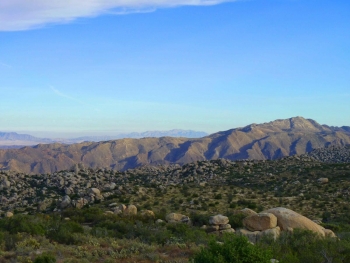
Supervisors have many potential reasons to deny permits for Tule Wind, from impacts on property values and community character to endangering public safety. The latter could leave the County liable for damages should a fire or other catastrophe occur, since Supervisors have been duly warned of the potential dangers.
If approval is granted, however, Supervisors would be prudent to require evidence that turbine and blade models, as well as manufacturers, have a proven track record of safety, particularly regarding fires--and for Supervisors to reserve the right to revoke permits if products chosen by Iberdrola are deemed unacceptably risky.







Comments
Energy (food) for
Energy (food) for thought:
"A single [coal] mine produces about 50 percent more energy on an average day than all the country’s solar panels and wind turbines combined."
http://www.city-journal.org/2012/22_3_coal.html
So install more panels.
Coal mines are the worst of all energy sources. In Appalachia they have blasted the tops off of 500 mountains, Craigs, and polluted the rivers with coal slag. Coal fired power plants are a major cause of asthma and other respiratory diseases.
I'm working on a story with all the numbers to document that we can meet our region's power needs with rooftop solar alone, not even counting parking lot solar. The power companies don't want us to know about this. So of course we will be shouting it to the rooftops!